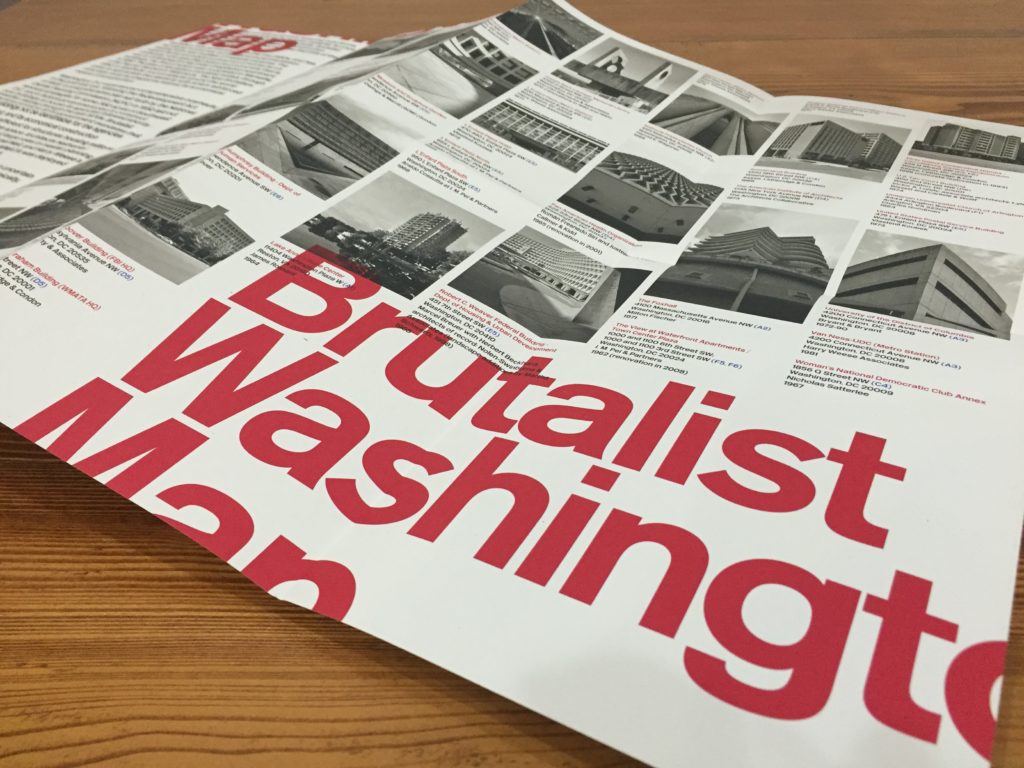New map celebrates Washington, D.C.’s Brutalist architecture
Brutalist Washington Map by Blue Crow Media in collaboration with Deane Madsen

The rising popularity of Brutalist architecture is being celebrated with the publication today of the Brutalist Washington Map by city guide publisher Blue Crow Media in collaboration with Deane Madsen of Architect Magazine.
The guide features 40 leading examples of Brutalist architecture from the Hirshhorn Museum and the J. Edgar Hoover Building (FBI HQ), Dulles Airport and Georgetown’s Lauinger Library to lesser known buildings like the the Woman’s National Democratic Club Annex, National Presbyterian Church and Reston’s Lake Anne Plaza. Details for each building and metro station, include the location, date and the architect or practice responsible.
Deane Madsen, Associate Editor of Design at Architect Magazine said: “As moreand more examples of classic Brutalism face demolition by neglect, we hope that putting these examples of D.C.’s Brutalist architecture on the map will foster public appreciation that ensures their longevity.”
Brutalism rose to prominence in the mid-1950s, and has its origins in post-war architectural experimentation dealing with new realities of material expense. The style’s forms and ethos evolved out of works by Le Corbusier, who specified béton brut (concrete that is raw or unfinished) in his Unité d’Habitation apartment buildings, the first of which was completed in Marseille in 1952. Architects around the world grew to appreciate the plasticity with which reinforced concrete could be shaped as well as its economical means of construction.
Washington, D.C. experienced comprehensive overhauls in the post-war era, following the Redevelopment Act of 1945. Brutalist architecture proved a fit for government mandates that the new buildings not be identifiable for the agencies they contained, and its economical construction methods proved efficient for structures housing millions of square feet of office space. Architects Nathaniel Owings and I.M. Pei played large roles in master planning efforts surrounding the National Mall, and Harry Weese’s vaulted Metro station design for WMATA was deployed throughout the region starting in 1976.
The Brutalist Washington Map is designed to affirm the value of these buildings and to inspire further consideration of Brutalist architecture today. Priced at $10 USD (£8 GBP) plus shipping, it is available to purchase through Blue Crow’s website, and at the National Building Museum shop in D.C. Two sided, with a map on one side and an introduction to Brutalism and post-war construction in Washington, along with architectural details for each building and photos on the other, it opens to 16.5 inches (420mm) x 23.5 inches (600mm) and folds down to 8.25 inches (210mm) x 6 inches (150mm), and is protected by wide band.
This is the Blue Crow Media’s fourth architecture guide, following Brutalist London Map, Art Deco London Map and Constructivist Moscow Map. Modern Berlin Map will be available in November 2016.
For press enquiries:
Derek Lamberton, Blue Crow Media
derek@bluecrowmedia.com , +44(0)75 4585 2718
About Blue Crow Media
Blue Crow Media is an award -winning London-based independent publisher of
distinctive city guide maps and apps. Brutalist Washington Map is Blue Crow
Media’s 14th folding map guide and second dedicated to Brutalist architecture.
Brutalist Boston Map will be published in 2017.
w: bluecrowmedia.com ; i: @bluecrowmaps ; t: @bluecrowmedia
About Deane Madsen
Deane Madsen is the associate editor of design at Architect Magazine. Based in
Washington, D.C., Madsen started @BrutalistDC as a way of celebrating the
capital city’s collection of Brutalist gems, which add texture to corridors of
all-glass lobbyist headquarters. Madsen earned a Master of Architecture degree
from UCLA before altering course to an architecture adjacent career writing about
what makes buildings work.
i: @deane_madsen ; t: @deane_madsen
